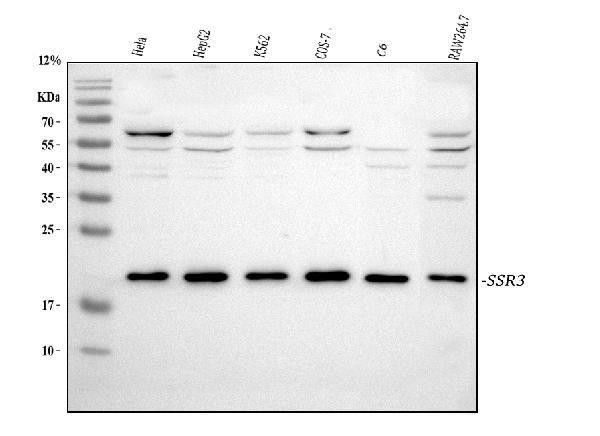
Figure 1. Western blot analysis of SSR3 using anti-SSR3 antibody (PA1796). Electrophoresis was performed on a 5-20% SDS-PAGE gel at 70V (Stacking gel) / 90V (Resolving gel) for 2-3 hours. The sample well of each lane was loaded with 30 ug of sample under reducing conditions. Lane 1: human Hela whole cell lysates, Lane 2: human HepG2 whole cell lysates, Lane 3: human K562 whole cell lysates, Lane 4: monkey COS-7 whole cell lysates, Lane 5: rat C6 whole cell lysates, Lane 6: mouse RAW264.7 whole cell lysates. After electrophoresis, proteins were transferred to a nitrocellulose membrane at 150 mA for 50-90 minutes. Blocked the membrane with 5% non-fat milk/TBS for 1.5 hour at RT. The membrane was incubated with rabbit anti-SSR3 antigen affinity purified polyclonal antibody (Catalog # PA1796) at 0.5 microg/mL overnight at 4°C, then washed with TBS-0.1%Tween 3 times with 5 minutes each and probed with a goat anti-rabbit IgG-HRP secondary antibody at a dilution of 1:5000 for 1.5 hour at RT. The signal is developed using an Enhanced Chemiluminescent detection (ECL) kit (Catalog # EK1002) with Tanon 5200 system. A specific band was detected for SSR3 at approximately 21 kDa. The expected band size for SSR3 is at 21 kDa.
Anti-SSR3 Antibody Picoband(r)

PA1796-FITC
ApplicationsImmunoFluorescence, Western Blot, ImmunoCytoChemistry, ImmunoHistoChemistry
Product group Antibodies
ReactivityHamster, Human, Monkey, Mouse, Rat
TargetSSR3
Overview
- SupplierBoster Bio
- Product NameAnti-SSR3 Antibody Picoband(r)
- Delivery Days Customer9
- Antibody SpecificityNo cross reactivity with other proteins.
- Application Supplier NoteTested Species: In-house tested species with positive results. Predicted Species: Species predicted to be fit for the product based on sequence similarities. By Heat: Boiling the paraffin sections in 10mM citrate buffer, pH6.0, for 20mins is required for the staining of formalin/paraffin sections. Other applications have not been tested. Optimal dilutions should be determined by end users.
- ApplicationsImmunoFluorescence, Western Blot, ImmunoCytoChemistry, ImmunoHistoChemistry
- CertificationResearch Use Only
- ClonalityPolyclonal
- Concentration500 ug/ml
- ConjugateFITC
- Gene ID6747
- Target nameSSR3
- Target descriptionsignal sequence receptor subunit 3
- Target synonymssignal sequence receptor subunit gamma; signal sequence receptor, gamma (translocon-associated protein gamma); SSR gamma; translocon-associated protein gamma subunit; translocon-associated protein subunit gamma; TRAP-complex gamma subunit; TRAPG; TRAP-gamma
- HostRabbit
- IsotypeIgG
- Protein IDQ9UNL2
- Protein NameTranslocon-associated protein subunit gamma
- Scientific DescriptionBoster Bio Anti-SSR3 Antibody catalog # PA1796. Tested in IF, IHC, ICC, WB applications. This antibody reacts with Human, Monkey, Mouse, Rat. The brand Picoband indicates this is a premium antibody that guarantees superior quality, high affinity, and strong signals with minimal background in Western blot applications. Only our best-performing antibodies are designated as Picoband, ensuring unmatched performance.
- ReactivityHamster, Human, Monkey, Mouse, Rat
- Storage Instruction-20°C,2°C to 8°C
- UNSPSC12352203









